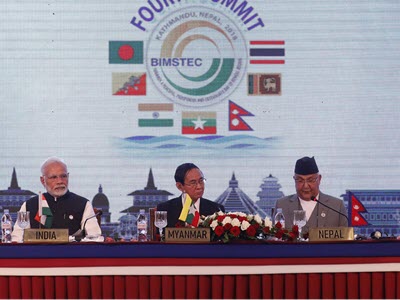Interview from Nontraditional Security Challenges in South Asia
Disaster Management and Regional Cooperation in the Bay of Bengal
NBR recently launched a new project to create a framework for cooperation on disaster management in South Asia. As part of this initiative, Thomas Lutken spoke with Sohini Bose, a junior fellow at the Observer Research Foundation (ORF) in Kolkata, regarding her research on disaster management and the role that the Bay of Bengal Initiative for Multi-Sectoral Technical and Economic Cooperation (BIMSTEC) plays in this field. She argues that broad stakeholder engagement and collaboration in disaster management at all levels will strengthen disaster preparedness in the region.
Developing a common language for disaster management is a key objective to ensure that collaborative efforts are made with a similar understanding of the goals and objectives. How do you define key terms such as mitigation, preparedness, response, and recovery? What kind of actions do they entail?
Disaster management essentially consists of three phases: early warning, disaster response, and disaster recovery. Preparedness, although often understood only in the context of disaster response (to indicate the degree of readiness to respond immediately to a disaster), is a vital component of all three phases. This is the term that is of utmost significance in any disaster vernacular because it enables responders to save time in emergency situations.
Preparedness in the first phase entails having proper early-warning systems in place along with functional dissemination networks, which will ensure that alerts are quickly disseminated to better safeguard life and infrastructure. At the level of disaster response, preparedness includes a diverse range of precautionary activities such as creating evacuation maps; having designated shelters for evacuees; storing food, clothes, medicines, and other relief essentials; and having trained volunteers for search and rescue operations. Preparedness at the disaster recovery stage is more complex. The actionable responses can be anticipated but not predetermined, as they depend on the type of disaster and the extent of damage caused. Nonetheless, in reconstruction as well as rehabilitation—both of which constitute “recovery”—preparedness involves having the capability to build back better (by inculcating disaster-risk resilience in the rebuilt infrastructure) and to guide the affected population back into a normal life by providing basic necessities without unnecessary delays.
Of these three phases of disaster management, disaster vernacular at the regional level emphasizes early warning and disaster response, as disaster recovery involves decisions that are often well within the purview of national jurisdiction. These include decisions about where the affected population will be rehabilitated and the number of resources to be allocated for reconstruction efforts. Within the Bay of Bengal Initiative for Multi-Sectoral Technical and Economic Cooperation (BIMSTEC), the focus on early warning is manifested through the Centre on Weather and Climate Change, which engages in weather prediction (among other activities), while a focus on disaster response is reflected in the recently launched BIMSTEC joint disaster management exercises.
Disasters affect every level of society. Is there a level (international, national, state, or city) that you feel is most critical for disaster management? Where can improvements be made in cooperation between these levels?
The Bay of Bengal is a turbulent maritime space prone to frequent cyclones and occasional tsunamis, which renders its littoral countries vulnerable to natural disasters. As disasters are often transnational threats, affecting people regardless of political boundaries, there is a need to develop a collective system to manage disasters and reduce the risks for the region. Hence, BIMSTEC identifies “environment and disaster management” as a priority sector of cooperation. Most of its member countries, except India, depend considerably on external assistance in times of crisis (particularly those of higher magnitude). To optimally harness the capacity for disaster management at the regional level, it is essential that concerns about mitigating natural disasters are channeled toward the creation of a collective disaster management system.
It is also important to enhance cooperation in disaster management in the form of information sharing and the exchange of best practices between the regional, national, and local levels. Coordination in early warning is particularly important in this context, as faster alerts would help save lives. Furthermore, local populations in disaster-prone areas are the worst affected and the first to respond when calamity strikes. Keeping in mind the cultural similarity of countries around the Bay of Bengal—especially among the coastal populations—the sharing of best practices between countries will benefit people living in vulnerable zones along the shoreline.
Are there key stakeholders who you feel are underrepresented in regional cooperation on disaster management? If so, who are they, and how can their considerations be better brought into the discussion?
Rather than emphasizing particular stakeholders, the priority at the regional level should be to increase the involvement of multiple stakeholders to develop a collective and multisectoral system of disaster management. Currently within BIMSTEC, regional management of disasters remains limited to the governments and the armed forces. Hence, there is a need for a more layered understanding of the problem wherein different stakeholders, such as ports, fishing communities, and the private sector (such as the tourism industry), are identified and their participation is ensured in discussions on how to reduce their sector’s vulnerability.
If disaster management is to be truly integrated across the region, it must be both holistic and domain-specific to ensure maximum effectiveness. For example, if the region can develop an early-warning system where hotlines are installed at different ports along the Bay of Bengal, this would enable early dissemination of alerts and thereby aid shipping traffic. Improving communication channels is also central to enhancing disaster management. The engagement of multiple stakeholders at the regional level to effectively manage natural disasters would not only help in devising a functional system of collective disaster management; in the long run, this could also usher in a culture of resilience to disaster risk in the region.
What is the future of regional-level disaster management in the Bay of Bengal?
Although BIMSTEC was established 24 years ago, its initiatives of cooperation in disaster management are still nascent. Only when faced with the overwhelming destruction caused by the Indian Ocean tsunami of 2004 did regional countries truly awaken to the need for cooperation. Although this led to a few years of vigorous engagement within BIMSTEC through deliberations at summit meetings and workshops, and the Centre for Weather and Climate Change saw success in its limited scope, the vibrancy was short-lived. As the memory of the disaster began to recede, the management of BIMSTEC at the regional level took a backseat to other policy and budget priorities.
However, in the current strategic atmosphere, where the Bay of Bengal has emerged as a cardinal strategic theater within the Indo-Pacific, its littorals are seeking more robust engagement with each other—both bilaterally and through BIMSTEC—to partake of economic opportunities like utilization of natural resources and to ensure stability by addressing security concerns like threats to freedom of navigation. In such a scenario, the BIMSTEC sector on disaster management provides an opportunity for strengthening inter-country diplomatic relations through confidence-building mechanisms such as joint disaster preparedness exercises. Hopefully, in the fortunate absence of another disaster of such magnitude as the 2004 tsunami, the strategic atmosphere in the Bay of Bengal will be a sufficient stimulus to develop a regional apparatus for disaster management. This issue is important, especially as natural hazards are likely to increase owing to climate change.
Sohini Bose is a Junior Fellow at the Observer Research Foundation (ORF) in Kolkata and a Doctoral Research Scholar in the Department of International Relations of the Jadavpur University. Her research interests include India’s maritime connectivity, strategic studies, geopolitics, and disaster management, with a special focus on the Indo-Pacific. Ms. Sohini received her M.Phil degree in international relations in 2018 from Jadavpur University.
This interview was conducted by Thomas Lutken, a project associate with the Energy and Environmental Affairs group at NBR.



